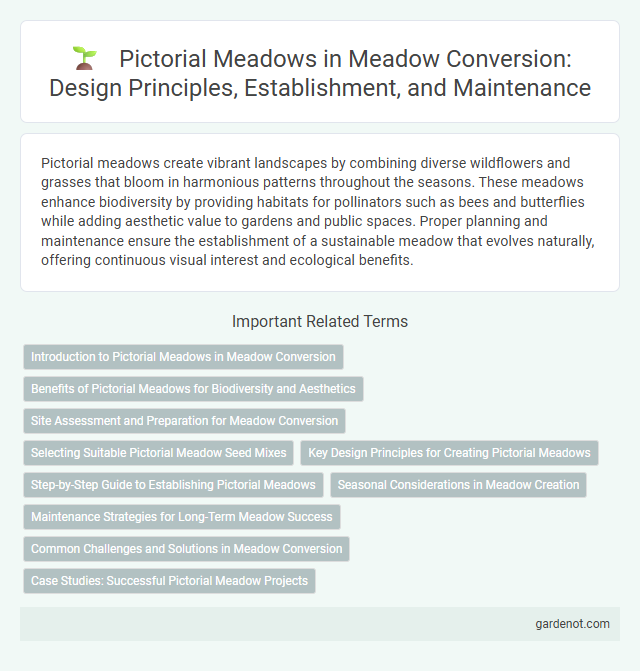Pictorial meadows create vibrant landscapes by combining diverse wildflowers and grasses that bloom in harmonious patterns throughout the seasons. These meadows enhance biodiversity by providing habitats for pollinators such as bees and butterflies while adding aesthetic value to gardens and public spaces. Proper planning and maintenance ensure the establishment of a sustainable meadow that evolves naturally, offering continuous visual interest and ecological benefits.
Introduction to Pictorial Meadows in Meadow Conversion
Pictorial meadows are designed landscapes that combine native wildflowers and grasses to create visually striking, low-maintenance habitats supporting biodiversity. This method of meadow conversion enhances ecological value by providing food and shelter for pollinators, birds, and other wildlife while promoting soil health and water retention. Integrating pictorial meadows in urban and rural settings offers sustainable solutions for green infrastructure and natural beauty.
Benefits of Pictorial Meadows for Biodiversity and Aesthetics
Pictorial meadows enhance biodiversity by providing diverse habitats that support pollinators, birds, and small mammals, promoting ecosystem stability. Their vibrant, natural floral patterns create visually captivating landscapes that improve aesthetic value in urban and rural settings. Increasing native plant species in pictorial meadows also aids soil health and water retention, contributing to sustainable land management.
Site Assessment and Preparation for Meadow Conversion
Site assessment for pictorial meadow conversion involves detailed analysis of soil quality, drainage patterns, and native flora to ensure optimal conditions for meadow establishment. Preparation includes removal of invasive species, soil aeration, and incorporation of organic matter to enhance nutrient availability and support diverse plant growth. Proper site preparation directly influences the success and sustainability of the meadow ecosystem, promoting biodiversity and visual appeal.
Selecting Suitable Pictorial Meadow Seed Mixes
Selecting suitable pictorial meadow seed mixes requires prioritizing native wildflower species that support local pollinators and enhance biodiversity. Seed mixes should include a balanced ratio of grasses and wildflowers adapted to regional soil and climate conditions, ensuring vibrant seasonal color and structural diversity. High-quality, certified seeds from reputable suppliers maximize germination rates and long-term meadow sustainability.
Key Design Principles for Creating Pictorial Meadows
Creating pictorial meadows involves selecting diverse native plant species that bloom in sequence to maintain continuous visual interest and support local pollinators. Incorporating varied colors, textures, and heights enhances the naturalistic aesthetic while promoting biodiversity. Strategic planting patterns mimic natural meadows, ensuring ecological balance and resilience.
Step-by-Step Guide to Establishing Pictorial Meadows
Establishing a pictorial meadow begins with selecting a sunny location with well-drained soil to optimize plant growth and biodiversity. Prepare the site by removing existing vegetation and loosening soil to enhance seed germination rates of native wildflowers and grasses. Sow a carefully chosen seed mix tailored to local climate and wildlife, then implement regular maintenance, including seasonal mowing and monitoring, to ensure long-term meadow health and vibrant seasonal blooms.
Seasonal Considerations in Meadow Creation
Pictorial meadows require careful planning of seasonal plant cycles to ensure continuous visual appeal from spring through autumn. Selecting a diverse mix of native wildflowers and grasses with staggered bloom times maximizes color variation and habitat benefits across different seasons. Timing the sowing and maintenance practices to local climate patterns enhances meadow establishment and long-term sustainability.
Maintenance Strategies for Long-Term Meadow Success
Effective maintenance strategies for pictorial meadows include regular selective weeding to prevent invasive species dominance and periodic mowing to promote diverse floral growth and seed dispersal. Soil health monitoring and adaptive irrigation practices enhance plant resilience and support biodiversity. Implementing seasonal assessments ensures the meadow's ecological balance and aesthetic appeal are sustained over time.
Common Challenges and Solutions in Meadow Conversion
Pictorial meadow conversion often faces challenges such as soil nutrient imbalance, invasive species proliferation, and inconsistent moisture levels. Effective solutions include soil testing and amendment to optimize nutrient availability, selective removal or control of invasive plants, and implementing irrigation or drainage strategies to maintain suitable moisture conditions. Regular monitoring and adaptive management enhance the resilience and biodiversity of converted meadows.
Case Studies: Successful Pictorial Meadow Projects
Case studies of successful pictorial meadow projects demonstrate substantial biodiversity enhancement and aesthetic appeal in urban and rural environments. Notable examples include the High Line in New York City, where native wildflowers and grasses created vibrant habitats attracting pollinators, and London's Queen Elizabeth Olympic Park, showcasing diverse floral compositions that support local ecosystems. These projects highlight effective seed mix selection, adaptive management practices, and community engagement as critical factors for sustaining flourishing pictorial meadows.
Pictorial meadow Infographic

 gardenot.com
gardenot.com